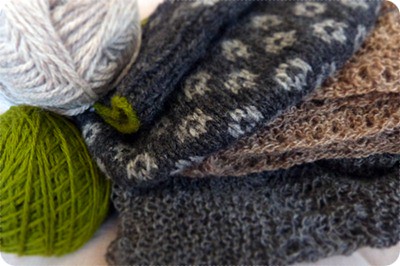Online identity, knitting celebrities and internet jealousy. We have covered a lot here recently. I'm going to return to the discussion but first I want to share a slice of what it is all about (for me, anyway): knitting.

This morning I cast off another sample for my Doggerland collection. I think I first mentioned the collection about a year ago - well it has been a long journey to get here and I'll write more about this as I release the patterns. But I just love looking at this pile of samples (plus random bits of yarn). The pile looks so right even if the samples still need to be dressed and it is lacking a couple of core pieces still to be knitted.
I am getting there! Woo!
And I think that brings me neatly round to the topic that Fourth Edition has been circling around recently: success.
Some people want a big car. Other people want to be recognised in the supermarket. All of us want to be able to pay our bills. I have spent a lot of time thinking about success and how I define it. I like being able to pay bills, but I am definitely not concerned with driving a car or being stopped in the street. No, I really truly love when what I produce resembles what has been going on in my head. When my brain and fingers work together to produce something that stays true to the core idea and tells the story I want to be telling.
'Story-telling' was a recurrent word in the discussion. It is perhaps a post-modern conceit that we tell stories in order to construct ourselves but I think I do relate to my craft and my designs as forms of story-telling. I want to explore my Scandinavian heritage; the landscapes both inside and outwith myself and try to make sense of the world through knitting.
I somehow worry(!) that I hover between textile art and textile craft - that somehow my ideas are too absurd and abstract for the relatively simple pleasure of working a piece of string with two sticks. I have spent almost 12 months trying to nail Doggerland because it started out as a huge, unwieldy idea. When I showed my introduction to some friends, the feedback was enthusiastic but agreed that maybe I should try to be a touch more accessible.
And so I am here looking at a pile of unblocked knits and I feel so proud. To me, this is success.
And this is who I am: I design knits inspired by psychogeography, land art, and Mesolithic archaeology. I wear red and green together. I am quiet in public and most happy when I'm with just a handful of friends. I love early 20th century culture and T.S. Eliot is my favourite writer. And I think the Eurovision Song Contest is the best thing since sliced bread. All that combined pretty much disqualifies me for any position as a lifestyle guru. Also, I eat the cake as soon as it's out of the oven.
Besides, the idea of a knitting celebrity is still weird. If the founder of Wikipedia has trouble identifying himself as 'internet famous', I think it's fair to say that we need to re-assess the whole idea of internet fame. The internet is an awfully big pond.




